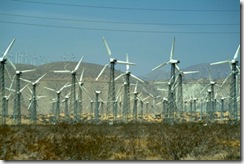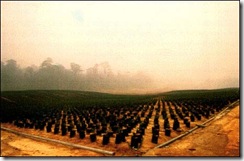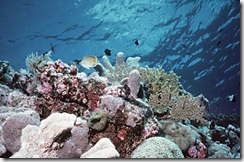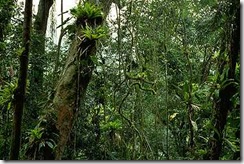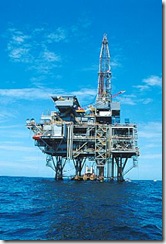This evening, beginning with Earth, Wind & Fire at 7/6C, the Documentary Channel will be airing five consecutive hours of documentaries that deal with alternative power sources; the effect of pollution on nature; the encroachment of development on the Amazonian rain forest, and the possibility of demand exceeding production of “cheap oil.”
Earth, Wind & Fire [7/5C] is a production of the Australian Broadcast Corporation’s 4 Corners newsmagazine. It examines the state of development of forms of alternative power in comparison with the State of California – and explores the possibility that the Australian federal government is backing the wrong horse with its policies that favor the development of “clean coal.”
The doc interviews members of the Australian federal and state governments; creators of various forms of alternative power [solar, wind and geothermal], and even a well-known venture capitalist and a “shadow cabinet” member of the opposition [and former leader of an issues-conscious rock band] as it looks into the differing approaches of California and Oz.
Overall, it’s a bit dry, but Earth, Wind & Fire does deal fairly with all points-of-view to arrive at a place where the intelligent viewer is able to make their own conclusions.
Final Grade: B+
Lost in Palm Oil [8/7C] is produced and directed by Inge Altemeier, a successful journalist and filmmaker. It examines the effect of the worldwide demand for palm oil on the indigenous people of Indonesia as that country’s rain forests are being destroyed to develop unsustainable palm plantations.
Because of a European Union directive that all gasoline must contain 20% biofuels by 2030, the demand for palm oil – already one of the most important components in the generation of foodstuffs – has increased exponentially. Altemeier looks at the effects of this demand on a tribe indigenous Indonesians who have lost their homes in the rain forest and exposes the corruption of the Indonesian government and the international banks that profit from that corruption [Deutsche Bank, ABN-AMRO and ING among them].
By far, the Bank Sinarmas has led the way in exploiting Indonesia’s rain forests for the lucrative palm oil crop. In speaking with Altemeier, Sinarmas spokesman Daud Dharsong comes off as shifty, sly and very much a propagandist [this despite a complete lack of any attempts to so paint him by the filmmaker].
The country’s current palm oil plantations take up twice the space of Belgium and a further area, larger than the United Kingdom is slated to be turned into similar plantations. Altemeier makes a good argument against palm oil being a “green resource” by noting that Indonesia is the world’s third largest creator of greenhouse gases.
Final Grade: B+
Beautiful One Day [9/8C], another 4 Corners production, shows how the coral reef off the coast of Australia is one of the planet’s greatest – and most beautiful – treasures is losing its luster because of pollution.
Easily the most beautifully filmed documentary of the evening, Beautiful One Day looks at the potential causes of damage, perhaps even fatal damage, to Australia’s Great Barrier Reef. Potential causes of that damage range from toxicity as a result of grounded ships; nutrients from human agriculture; damage from prawn trawling; possible oil slicks and global warming.
As most of the world’s coral reefs are dying, the Great Barrier Reef seems to have suffered little damage, but even it has suffered small amounts coral bleaching – caused by rapidly warming waters due to global warming. Runoffs from the cane farms near the coast are another concern, as are runoffs from farms further inland – though some enterprising farmers have taken steps to change that.
Beautiful One day examines the subject of the Great Barrier Reef’s survival and speaks to cane farmers; inland farmers, prawn trawlers and the federal government minister whose portfolio includes guarding the reef, David Kemp, among others. Various points of view are espoused and some are given more than others in the form of government documentation and examples of how various effects have killed other reefs.
Final Grade: A
Daughters of the Canopy [10/9C] looks at the threat to the Amazon rain forest and the efforts of the women of the Amazon to protect – flying in the face of not only the loggers who could destroy it, but their own male-dominated society.
In a sense, Daughters of the Canopy could be titled Feminism Comes To The Amazon Rain Forest. It is a documentary that looks at how the inhabitants of the Amazon rain forest were, essentially, conned by ranchers and developers who took advantage of the under-educated men of the region to buy their land – or force them from it – and how the efforts of researchers like Dr. Patricia Shanley and local women like Gloria Gaia helped make it possible for the women of Amazonia to gain the education and organization needed to resist further exploitation of the rain forest.
Centered around the two communities of Nova Timboteua and Quinandeua, Daughters of the Canopy shows how the efforts of such as Shanley and Gaia led to the formation of a farmers’ union by the women farmers – though its membership is not gender exclusive, and how the people of these communities learned the value of the rain forest homes.
By using these two communities, writer/director Trilby MacDonald shows how the women of Amazonia have mobilized and become a political force and source of inspiration that might yet save their rain forest home.
Final Grade: A
Peak Oil? [11/10C] deals with the concept that at some point, the world’s demand for oil will outstrip its production. This third 4 corners documentary looks at current oil production and pricing and some of the causes – including increased consumption and stock market speculators.
Then it tackles the actual concept of “Peak Oil.” A conversation with Colin Campbell of the association for the Study of Peak Oil [ASPO] finds him placing the reaching of the “Peak Oil” moment sometime in 2010. He quotes from his own research that finds thirty-three of the most important oil producers, production has long since peaked – and notes that it’s been forty years since the last major discovery of new oil.
On the other side of the argument, Sadad Al-Husseini, Former director of Saudi Aramco, says his country’s claim that they will be able to keep up with world consumption for years to come – though he admits that it will be much more expensive [all the “easy oil” is pretty much gone].
Peak Oil? is the most interestingly shot of the evening’s docs, framed as it is by scenes from Mad Max, illustrating a world where gasoline is the most precious commodity on Earth. Besides quoting the experts listed above, the doc also cites Bill Wells of global ethanol; Robert Hirsch, Consultant to the U.S. Department of Energy; Farouk Al-Zanki, Chairman of the Kuwait Oil Company – plus members of the American and Australian government, all of whom concede that oil prices are not going down any time soon – at the very least…
The result is one of the most thought-provoking and potentially alarming hours of television I’ve seen.
Final Grade: A
